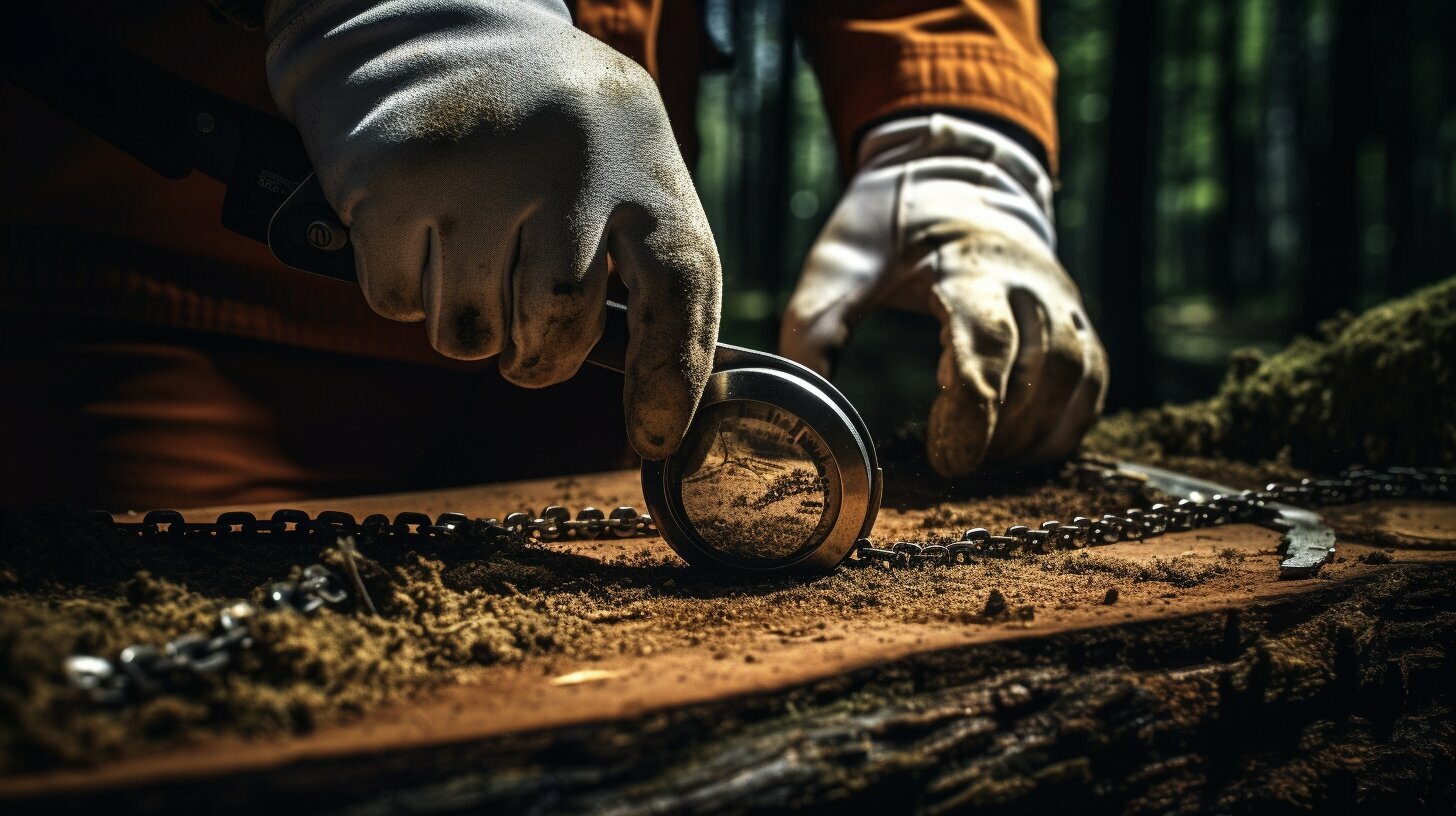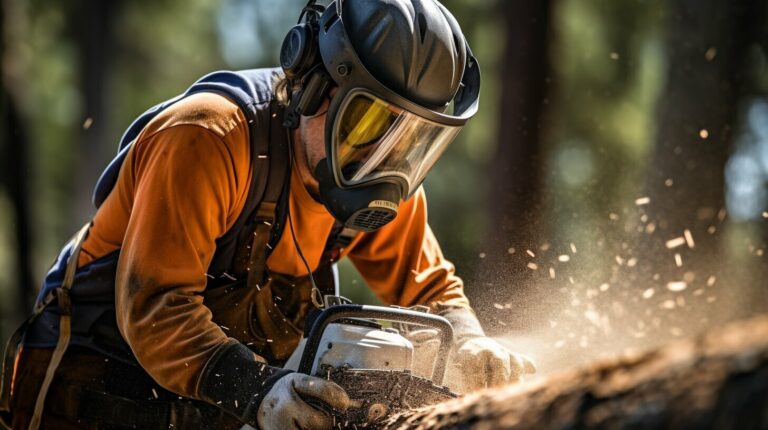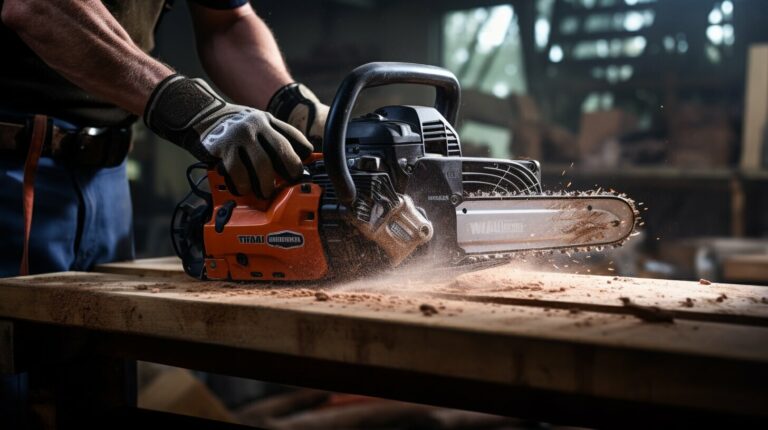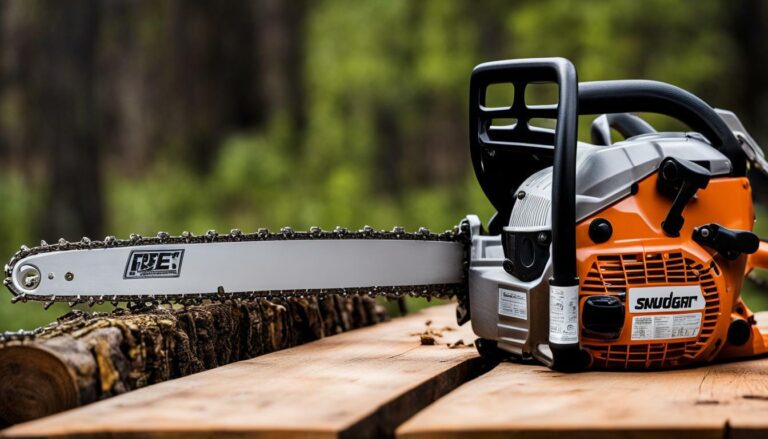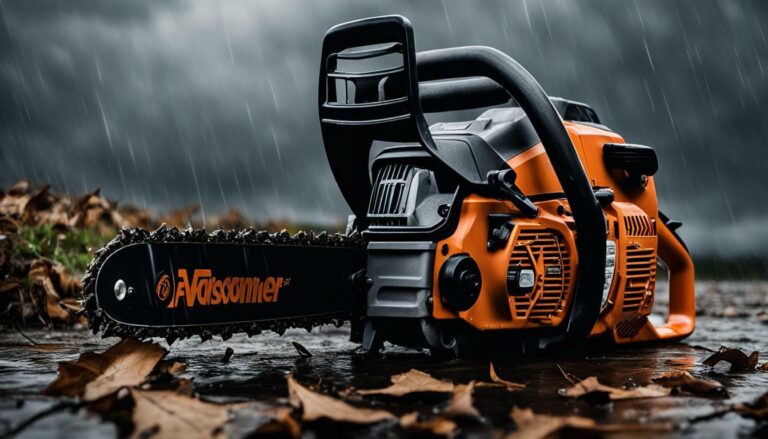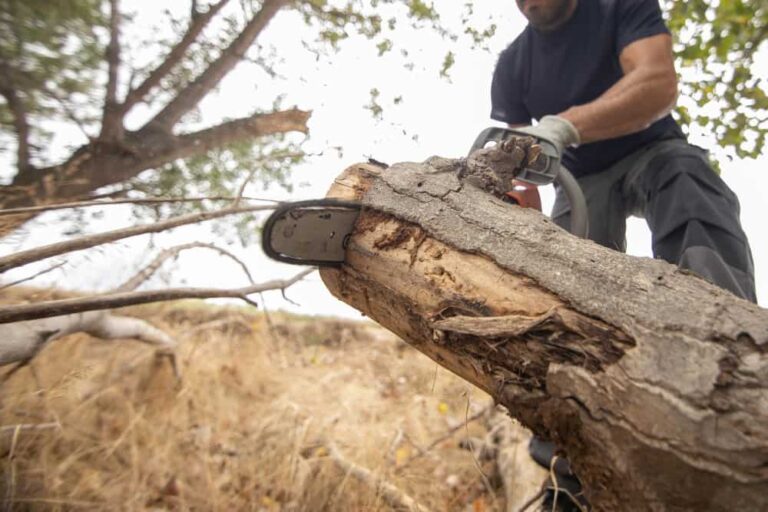How Many Times Can You Sharpen a Chainsaw Chain? Discover It Now!
Maintaining a sharp chainsaw chain is crucial for efficient cutting and prolonging the life of your chainsaw. Regularly sharpening your chainsaw chain not only ensures clean and precise cuts but also extends its lifespan, saving you money on frequent replacements. But How Many Times Can You Sharpen a Chainsaw Chain before it needs to be replaced? Let’s explore the optimal chainsaw chain sharpening interval and factors that affect the frequency of sharpening.
Key Takeaways:
- A chainsaw chain can typically be sharpened up to 10 times, sometimes more, depending on wear and how much metal is removed during each sharpening.
- Signs that indicate your chainsaw chain needs sharpening include producing fine sawdust instead of wood chips, difficulty in cutting, smoking while cutting, and dull or uneven cuts.
- The frequency of sharpening is influenced by factors such as the type of wood being cut, the workload of the chainsaw, hitting dirt or hard objects, and the type of cutter on the chain.
- Avoid over-sharpening the chain, as it can reduce its overall lifespan. Proper storage, avoiding contact with dirt, maintaining proper chain tension, and regular lubrication can help prolong the sharpness of your chainsaw chain.
- You can sharpen your chainsaw chain using a round file and a vise following a step-by-step process.
Signs That a Chainsaw Chain Needs Sharpening
Knowing when to sharpen your chainsaw chain is essential for safe and efficient cutting. Over time, the chain can become dull due to continuous use and contact with various materials. Here are some signs that indicate it’s time to sharpen your chainsaw chain:

- The chainsaw is producing fine sawdust instead of wood chips. When sharp, it should create clean and consistent wood chips as it cuts through the material. If you notice fine sawdust instead, it indicates that the chain is not cutting properly and needs sharpening.
- You experience difficulty in cutting. A dull chainsaw chain will struggle to cut through wood smoothly. It may require additional effort and cause the chainsaw to vibrate excessively. If you exert more force than usual, it’s a sign that your chain needs sharpening.
- The chainsaw is smoking while cutting. When a chainsaw chain is dull, it generates excessive heat and friction, resulting in smoke. If you notice smoke coming from while cutting, it’s time to sharpen it immediately to prevent damage to the chain and the saw.
- Your cuts are dull or uneven. A sharp chainsaw chain creates clean, precise cuts. However, a dull chain will leave behind rough, uneven cuts that may require additional finishing. If your cuts are no longer clean and smooth, it indicates that it needs sharpening.
To ensure optimal performance and prolong the lifespan of your chainsaw chain, it’s important to pay attention to these signs and sharpen the chain as needed. By maintaining a sharp chain, you can achieve safer and more efficient cutting results.
Factors Affecting the Frequency of Sharpening
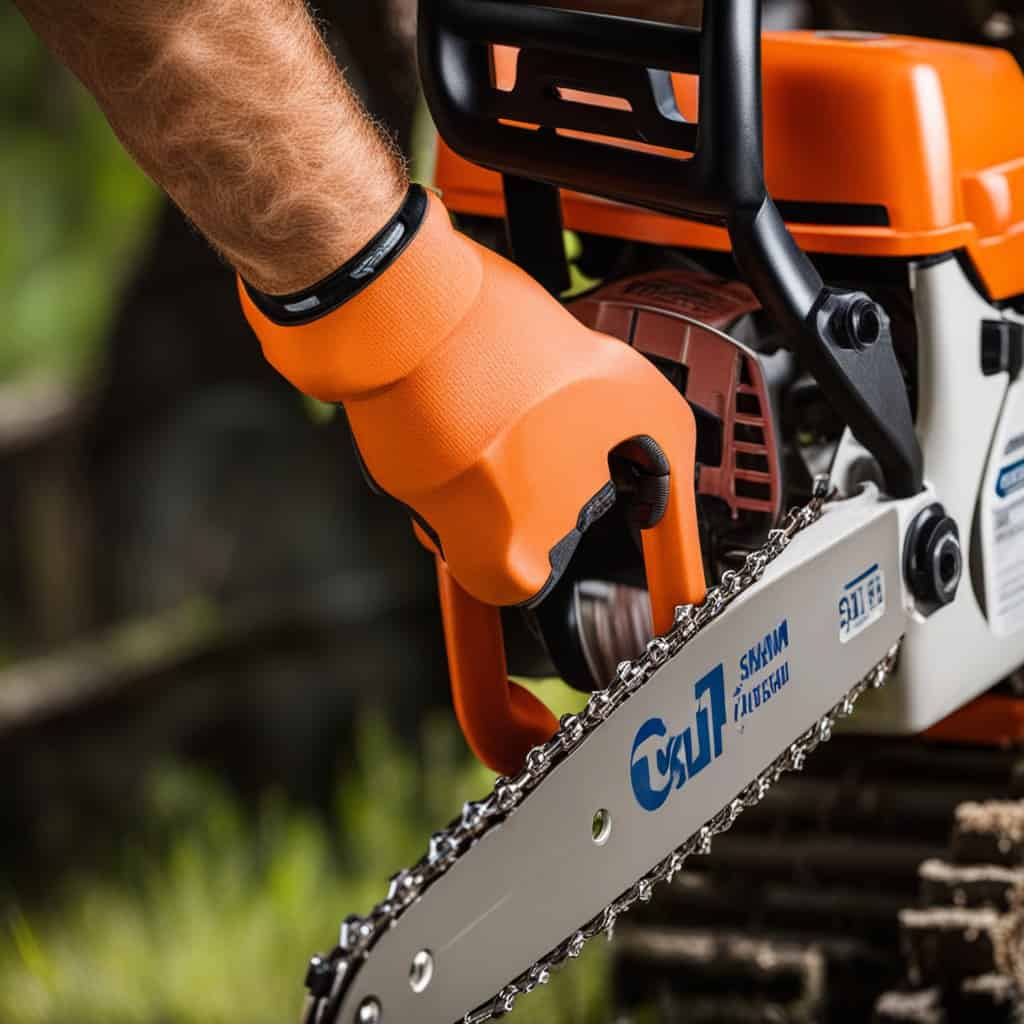
Several factors can affect how often you sharpen a chainsaw chain, and understanding them will help you maintain optimal cutting performance. The type of wood being cut plays a crucial role, as harder woods like oak or hickory can quickly dull the chain compared to softer woods like pine or cedar.
Additionally, the amount of work your chainsaw performs also impacts the frequency of sharpening. If you regularly use your chainsaw for heavy-duty tasks, such as felling large trees or cutting firewood, you may need to sharpen the chain more frequently.
Hitting dirt or hard objects while cutting can significantly impact the chain’s sharpness. When it comes into contact with these materials, it can quickly dull the cutting edges. It’s important to take care and avoid these obstacles as much as possible to prolong the lifespan.
The cutter type on the chain, such as full chisel or semi-chisel, can also influence chainsaw sharpening frequency. Full chisel cutters tend to dull faster but offer faster cutting speeds, while semi-chisel cutters are more durable but have slightly slower cutting speeds.
To maintain the longevity, it’s essential to avoid over-sharpening. Removing excessive amounts of metal can shorten the lifespan, so it’s crucial to balance keeping it sharp and not overdoing it. Proper tension is also vital for optimal cutting performance. A loose chain can lead to inefficiency and increased wear, while an overly tight one can strain the engine and wear out prematurely. Lastly, ensuring proper lubrication is crucial, as it reduces friction and heat, allowing it to stay sharp for longer periods.
| Factors Affecting Sharpening Frequency | Impact on Sharpening Frequency |
|---|---|
| Type of Wood | Harder woods require more frequent sharpening |
| Workload | Heavy-duty tasks require more frequent sharpening |
| Obstacles | Hitting dirt or hard objects can quickly dull the chain |
| Cutter Type | Full chisel cutters may require more frequent sharpening |
| Over-sharpening | Excessive removal of metal shortens chain lifespan |
| Chain Tension | Proper tension ensures optimal cutting performance |
| Lubrication | Proper lubrication reduces friction and extends chain sharpness |
How Many Times Can You Sharpen a Chainsaw Chain: Proper Maintenance Lifespan
Proper chainsaw maintenance is essential for maximizing the lifespan of your chainsaw chain and ensuring optimal cutting performance. By taking a few simple steps, you can prolong the life of your chain and avoid costly replacements. Here are some best practices for chainsaw chain maintenance:
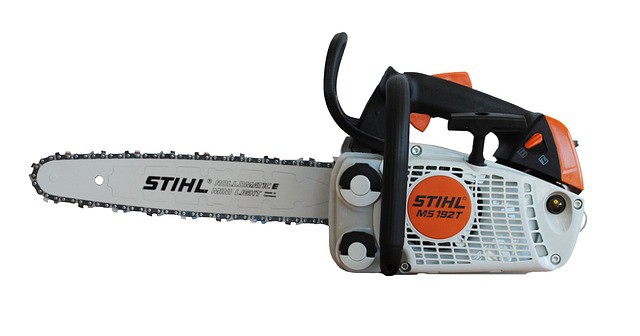
- Storage: When not in use, store your chainsaw in a dry and clean area, away from moisture and dust. This will prevent corrosion and ensure that your chain stays sharp for longer.
- Avoid hitting the dirt: Be careful when cutting near the ground to avoid hitting dirt or hard objects. This can cause the chain to dull quickly and reduce its overall lifespan.
- Maintain proper chain tension: Regularly check the tension of your chainsaw chain and adjust it as needed. A too-loose or tight chain can affect cutting performance and increase wear on the chain.
- Ensure proper lubrication: Lubricate the chain regularly to reduce friction and prevent premature wear. Use a high-quality chainsaw bar oil and apply it to the chain while it is rotating to ensure even distribution.
By following these best practices, you can significantly prolong the lifespan of your chainsaw chain and ensure that it remains sharp and efficient. Remember also to monitor the signs that indicate the chain needs sharpening, such as difficulty in cutting or producing fine sawdust instead of wood chips. Regular sharpening using a round file and a vise will help maintain the chain’s cutting performance and extend its overall life. With proper chainsaw maintenance, your chainsaw chain will be ready to tackle any cutting task with ease.
| Best Practices for Chainsaw Chain Maintenance |
|---|
| Store your chainsaw in a dry and clean area |
| Avoid hitting dirt or hard objects |
| Maintain proper chain tension |
| Ensure proper lubrication |
Implementing these practices will help you get the most out of your chainsaw chain, saving you time and money in the long run. Proper maintenance not only extends the lifespan of your chain but also ensures optimal cutting performance, making your chainsaw a reliable tool for years to come.
How to Sharpen a Chainsaw Chain
Learning how to sharpen a chainsaw chain properly will help you maintain its cutting efficiency and save money on replacement chains. With regular sharpening, you can extend the lifespan of your chainsaw chain and ensure optimal performance. Here are some techniques to help you sharpen your chainsaw chain effectively:
- Start by securing the chainsaw bar and chain in a vise to keep them stable during the sharpening process.
- Identify the cutting teeth on the chainsaw chain. These teeth have a curved shape and are positioned on one side of the chain.
- Take a round file that matches the size of your chainsaw chain and place it in the groove between two cutting teeth at a 90-degree angle.
- Apply light pressure and move the file across the tooth in a smooth, controlled motion. Repeat this process for each cutting tooth on the chain, ensuring you maintain the same filing angle.
- After filing all the cutting teeth on one side of the chain, flip the chainsaw bar and repeat the process for the teeth on the other side.
- Inspect the depth gauge or raker teeth, the small protrusions in front of each cutting tooth. Use a depth gauge tool to ensure they are properly set. Adjust them if necessary to maintain the recommended depth for your chainsaw chain.
- Once you have finished filing and adjusting the teeth, use a chainsaw file guide to check the sharpness of the cutting teeth. If necessary, perform additional filing to achieve the desired sharpness.
Remember to wear safety gear, such as gloves and eye protection, during the sharpening process. Additionally, refer to your chainsaw’s manual for specific instructions and guidelines on sharpening your particular model of chainsaw chain.
| Sharpening Tips |
|
|---|
By following these chainsaw chain sharpening techniques, you can keep your chainsaw performing at its best and prolong its lifespan. Regular maintenance and sharpening will not only save you money but also ensure safer and more efficient cutting.
Conclusion

How Many Times Can You Sharpen a Chainsaw Chain is crucial for maintaining safe and efficient cutting, prolonging the life of your chainsaw, and saving money in the long run. A chainsaw chain can typically be sharpened up to 10 times, sometimes even more, before needing to be replaced. The number of times it can be sharpened depends on factors such as the amount of wear the chain incurs and the amount of metal removed during each sharpening.
Signs that indicate it’s time to sharpen your chainsaw chain include producing fine sawdust instead of wood chips, difficulty in cutting, smoking while cutting, and dull or uneven cuts. These signs signify that the chain is no longer sharp enough to cut through wood effectively, and it’s time to sharpen it to maintain optimal performance.
Several factors influence the chainsaw chain sharpening frequency, such as the type of wood being cut, the amount of work the chainsaw is used for, hitting dirt or hard objects, and the type of cutter on the chain. It’s important to strike a balance and avoid over-sharpening the chain, as excessive sharpening can reduce lifespan.
In addition to regular sharpening, proper maintenance steps should be taken to extend the lifespan of your chainsaw chain. This includes storing the chainsaw properly to prevent damage, avoiding hitting the dirt or hard objects while cutting, maintaining proper chain tension to ensure smooth operation, and ensuring proper lubrication to minimize friction and wear.
When it’s time to sharpen your chainsaw chain, you can use a round file and a vise to achieve the desired sharpness. Following the correct sharpening technique will ensure a sharp and efficient cutting performance when you use your chainsaw.
In summary, by regularly sharpening your chainsaw chain and following proper maintenance practices, you can ensure safe and efficient cutting, prolong the life of your chainsaw, and save money by extending the lifespan of your chainsaw chain.
FAQ
How many times can a chainsaw chain be sharpened?
A chainsaw chain can typically be sharpened up to 10 times, sometimes even more, before needing to be replaced. The number of times a chain can be sharpened depends on factors such as wear and the amount of metal removed during each sharpening.
What are the signs that a chainsaw chain needs sharpening?
Signs that a chainsaw chain needs sharpening include producing fine sawdust instead of wood chips, difficulty in cutting, smoking while cutting, and dull or uneven cuts.
What factors affect the frequency of sharpening?
Factors that affect the frequency of sharpening include the type of wood being cut, the amount of work the chainsaw is used for, hitting dirt or hard objects, and the type of cutter on the chain.
How can I extend the lifespan of my chainsaw chain?
Proper storage, avoiding hitting the dirt, maintaining proper chain tension, and ensuring proper lubrication can help keep the chainsaw chain sharp for longer.
How do I sharpen a chainsaw chain?
To sharpen a chainsaw chain, you can use a round file and a vise. It is important to follow proper sharpening techniques to maintain the chain’s performance and longevity.
